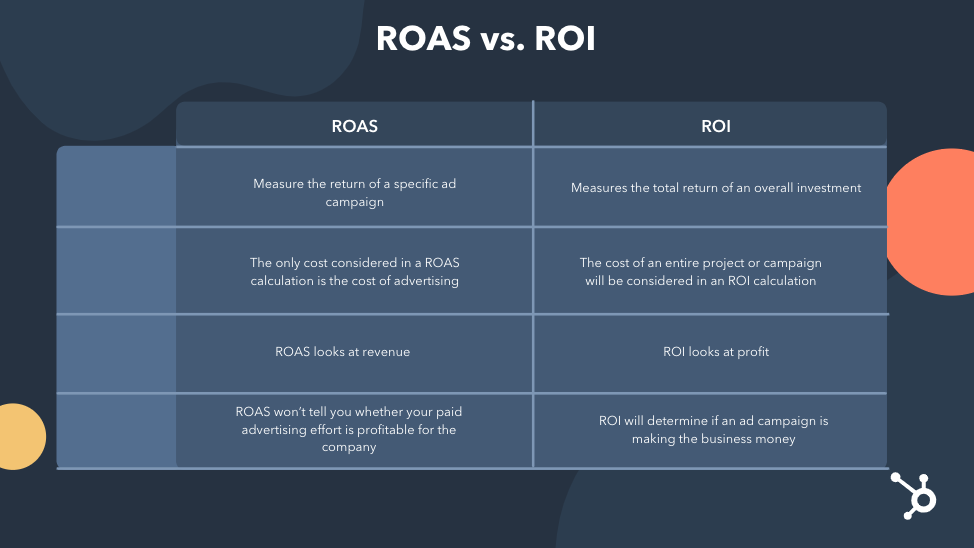As a writer, I've never been very good at math. I know … shocking.
Most marketers can relate because as a bunch, we tend to be better at English and history than math and science.
However, as a marketer, we need to be able to analyze data and calculate the effectiveness of an article or campaign, even though math might not be our strong suit.
One of the calculations we need to run and metrics we need to track is return on ad spend (ROAS).
Below, let's review ROAS. In this post, we'll discuss what ROAS is, how it's different from ROI, and how to calculate it.
Ultimately, ad spend is meant to measure the effectiveness of a specific ad campaign, not your overall ROI -- more on that below.
Besides ROAS, you'll most likely measure other metrics such as click-through rate and ROI. By measuring multiple metrics, you'll get a more accurate view of your results.
Of course, measuring performance and tracking analytics is an important part of any marketing campaign.
By tracking performance, you can improve and iterate on your marketing techniques. Plus, data is one of the only ways to truly prove that your department brings in revenue, which is incredibly important.
However, it's important to note that not everything can be measured with quantitative data. For instance, calculating brand awareness and sentiment is much more difficult. And while you can calculate downloads or email sign-ups, those might not always lead to revenue.
When you're analyzing any data, it's important to consider context and review qualitative data as well as quantitative data.
That being said, today we're going to dive into ROAS specifically. Before we do that, let's review how ROAS is different from ROI.

Ultimately, this means that the only cost considered in a ROAS calculation is the cost of advertising. On the other hand, the cost of an entire project or campaign will be considered in an ROI calculation.
The goal of your ads campaign, of course, will be to generate a positive return on your ad spend. However, how can you determine what that ad spend should be?
In the YouTube video below, HubSpot details how to determine ad spend by understanding the bidding system used by ad networks.
You'd use ROAS to help you determine how you spend your advertising budget and as a signal to determine if your campaigns are successful. This would let you know that you might need to evaluate your approach to running ads.
So, at this point, you might be wondering, "How can I calculate ROAS?" Let's review that now.
While the equation is simple, you might face difficulty gathering the data needed to run this calculation. For instance, calculating the cost of an ad isn't always easy. You'll need to consider the cost of the ad bid, the labor cost for the time it took to create the creative assets, vendor costs, and affiliate commissions.
But it's important to get an accurate estimate of the actual money spent on an ad to get an accurate ROAS measurement. If your data isn't accurate, your findings won't be either.
 Additionally, if you don't run an ecommerce business, it can also be difficult to measure the revenue generated by an ad. For example, someone might convert from your ad because they downloaded an ebook, however, they haven't spent any money yet. In fact, they might not spend money for months.
Additionally, if you don't run an ecommerce business, it can also be difficult to measure the revenue generated by an ad. For example, someone might convert from your ad because they downloaded an ebook, however, they haven't spent any money yet. In fact, they might not spend money for months.
To combat this, you can use a CRM software like HubSpot in conjunction with HubSpot Ads, to track revenue made from leads.
With a CRM and ads software, you can keep track of your data and tie it all together -- marketing leads, ad results, etc.

Now, you might be wondering, "What's a good ROAS?" and "How can I improve my ROAS?"
Well, a good ROAS is typically around 3:1. If you're barely breaking even, it might be time to dig further into the accuracy of your metrics and evaluate your ads and bidding strategy.
However, it's important to note that the objective of some ad campaigns might not be to make immediate revenue but to increase brand awareness. If that's your objective, then a lower ROAS makes sense.
What is a good ROAS?
Depending on the medium, return on ad spend can be anywhere from $4-11 for every dollar spent on advertising.
In the graphic below, you can see the ROAS per dollar invested in the United States in 2018, by the medium.
For each dollar invested in digital search advertising, U.S. advertisers gained about 11 U.S. dollars, making it the medium with the highest return on advertising spending.
How to Increase ROAS
To improve your ROAS, you can lower your ad spend and review your ads campaigns. You might want to optimize your landing pages or rethink your negative keywords.
Overall, ROAS is an important metric to track, but it shouldn't be tracked in a vacuum. It's important to look at other data and metrics to get the full picture of your return on investment.
Editor's note: This post was originally published in July 2020 and has been updated for comprehensiveness.










